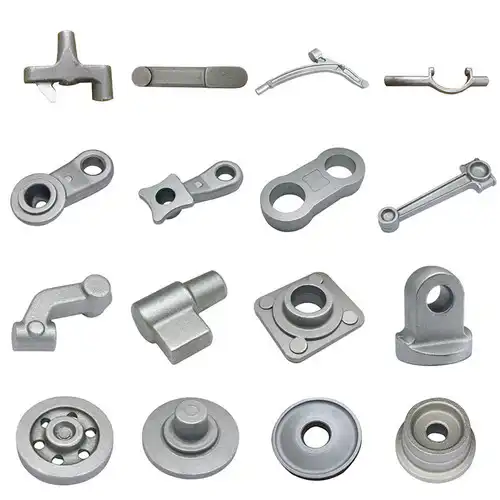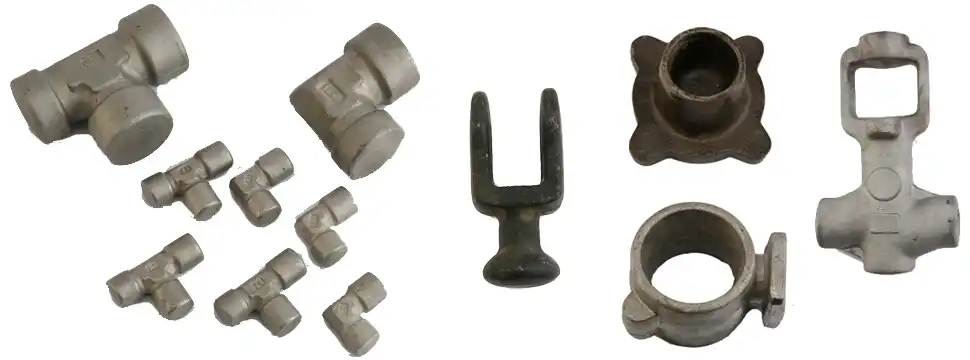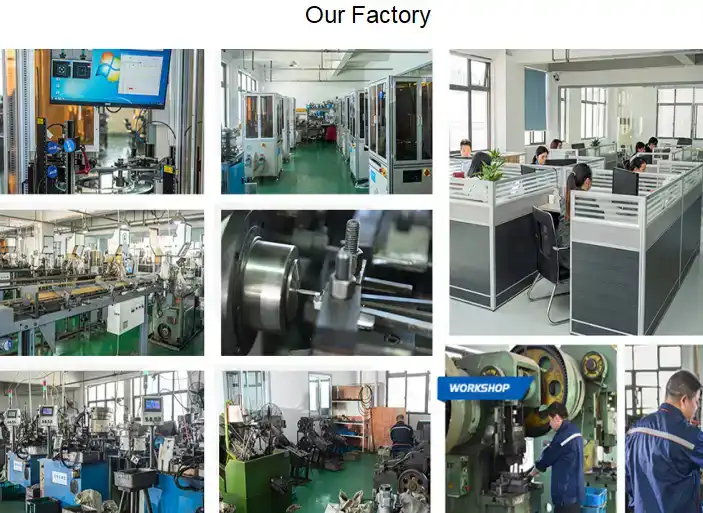How Do Forged Steel Mechanical Parts Ensure Safety in Automotive and Oil & Gas Systems?
2025-08-12 15:52:56
In today's demanding industrial landscape, safety remains the paramount concern across automotive and oil & gas sectors. The critical role of forged steel mechanical parts in ensuring operational safety cannot be overstated, as these precision-engineered components form the backbone of essential systems that protect both personnel and equipment. Through advanced metallurgical processes and rigorous quality control measures, forged steel mechanical parts deliver exceptional strength, durability, and reliability under extreme operating conditions. Their superior grain structure, achieved through controlled deformation processes, provides enhanced mechanical properties that significantly reduce the risk of catastrophic failures in high-stress applications, making them indispensable for maintaining safety standards in these critical industries.

Material Properties and Structural Integrity of Forged Steel Components
Enhanced Grain Structure for Superior Mechanical Performance
The manufacturing process of forged steel mechanical parts fundamentally transforms the material's microstructure, creating a refined grain pattern that significantly enhances mechanical properties compared to cast or machined alternatives. During the forging process, the metal is subjected to controlled plastic deformation at elevated temperatures, which breaks down the coarse dendritic structure typical of cast metals and replaces it with a fine, uniform grain structure. This transformation results in forged steel mechanical parts exhibiting superior tensile strength, improved fatigue resistance, and enhanced impact toughness. The directional grain flow achieved through forging follows the contours of the component, creating continuous fiber lines that resist crack propagation and provide optimal load distribution. In automotive applications, this enhanced grain structure ensures that critical components like connecting rods, crankshafts, and suspension components can withstand millions of stress cycles without failure. Similarly, in oil and gas systems, forged steel mechanical parts used in valve bodies, wellhead components, and pipeline fittings benefit from this improved microstructure, providing reliable performance under extreme pressure and temperature conditions while maintaining structural integrity over extended service periods.
Dimensional Accuracy and Consistency in Critical Applications
Precision manufacturing of forged steel mechanical parts requires meticulous attention to dimensional accuracy and consistency, factors that directly impact safety performance in automotive and oil & gas applications. Modern forging techniques, combined with advanced quality control measures, enable manufacturers to achieve tolerances as tight as ISO 2768-m standards, ensuring that each component meets exact specifications required for proper fit and function. The dimensional stability of forged steel mechanical parts is particularly crucial in applications where precise clearances and mating surfaces are essential for safe operation. In automotive transmission systems, gear teeth profiles must maintain exact dimensions to ensure proper meshing and load distribution, preventing premature wear and potential failure. The consistent dimensional accuracy achieved through precision forging processes eliminates the variability often associated with other manufacturing methods, providing predictable performance characteristics that safety engineers can rely upon. Quality control protocols implemented throughout the forging process, including statistical process control and coordinate measuring machine inspection, ensure that every forged steel mechanical part meets stringent dimensional requirements. This level of precision is essential for maintaining the tight tolerances required in hydraulic systems, where even minor dimensional variations can lead to leakage, pressure loss, or catastrophic system failure.
Material Traceability and Certification Requirements
The safety-critical nature of automotive and oil & gas applications demands comprehensive material traceability and certification protocols for forged steel mechanical parts. Each component must be traceable back to its raw material source, heat treatment records, and manufacturing process parameters to ensure compliance with industry standards and regulatory requirements. Material certification documents provide detailed information about chemical composition, mechanical properties, and heat treatment conditions, enabling end users to verify that forged steel mechanical parts meet specific application requirements. In the oil and gas industry, components used in pressure vessels, wellhead equipment, and pipeline systems must comply with strict material specifications such as API standards, ASME codes, and NACE requirements for corrosion resistance. The traceability system maintains detailed records of material lot numbers, processing parameters, and inspection results, providing a complete audit trail that can be referenced in case of field issues or regulatory inquiries. This comprehensive documentation system ensures that forged steel mechanical parts can be quickly identified and replaced if manufacturing defects are discovered, minimizing safety risks and operational downtime. The certification process also includes non-destructive testing methods such as ultrasonic inspection, magnetic particle testing, and dye penetrant examination to detect internal defects that could compromise component integrity during service.
Manufacturing Processes and Quality Control Standards
Advanced Forging Techniques and Process Control
The production of safety-critical forged steel mechanical parts relies on sophisticated manufacturing processes that combine traditional forging expertise with modern technology and precise process control. Contemporary forging operations utilize computer-controlled hammers, presses, and heating systems to maintain consistent processing parameters throughout the manufacturing cycle. The forging process begins with careful selection of high-grade raw materials, including alloy steels, carbon steels, and specialty grades that provide the mechanical properties required for specific applications. Precise temperature control during heating ensures uniform austenite formation and prevents grain growth that could compromise mechanical properties. The forging sequence is carefully designed to achieve optimal material flow and eliminate internal defects such as voids, inclusions, or segregation that could lead to premature failure in service. Advanced forging techniques such as isothermal forging and precision forging enable manufacturers to produce forged steel mechanical parts with near-net shapes, reducing machining requirements and preserving the beneficial effects of the forged grain structure. Process monitoring systems continuously track critical parameters such as temperature, pressure, and deformation rates, providing real-time feedback that ensures consistent quality and enables immediate corrective action if process variations are detected.
Heat Treatment and Surface Finishing Optimization
The heat treatment process plays a crucial role in developing the final mechanical properties of forged steel mechanical parts, directly influencing their safety performance in automotive and oil & gas applications. Controlled heat treatment cycles, including normalizing, quenching, and tempering operations, are carefully designed to achieve the optimal balance of strength, toughness, and ductility required for specific service conditions. The heat treatment process must be precisely controlled to ensure uniform properties throughout the component cross-section, preventing the formation of residual stresses that could lead to distortion or cracking during service. Modern heat treatment facilities utilize computer-controlled furnaces with precise temperature uniformity and atmosphere control to ensure consistent results. The tempering process is particularly critical for forged steel mechanical parts, as it reduces brittleness while maintaining strength levels, providing the toughness required to resist impact loading and prevent brittle fracture. Surface finishing operations, including shot peening, grinding, and polishing, are employed to enhance fatigue resistance and remove surface defects that could serve as crack initiation sites. These finishing processes create beneficial compressive residual stresses in the surface layer, significantly improving fatigue life and resistance to stress corrosion cracking in aggressive environments typical of oil and gas applications.
Comprehensive Testing and Inspection Protocols
Safety-critical forged steel mechanical parts undergo rigorous testing and inspection protocols to verify compliance with design specifications and industry standards. The inspection process begins with incoming material certification and continues through each manufacturing stage, culminating in final dimensional and mechanical property verification. Mechanical testing includes tensile testing, hardness measurement, impact testing, and fatigue evaluation to ensure that forged steel mechanical parts possess the required strength and toughness characteristics. Non-destructive testing methods such as ultrasonic inspection, magnetic particle testing, and radiographic examination are employed to detect internal defects that could compromise component integrity. Statistical process control techniques are used to monitor manufacturing consistency and identify trends that might indicate process variations requiring corrective action. The inspection process also includes verification of surface finish, dimensional accuracy, and geometric tolerances using coordinate measuring machines and optical inspection systems. All inspection results are documented and maintained as part of the permanent quality record, providing traceability and supporting continuous improvement efforts. Third-party certification and validation may be required for certain applications, particularly in the oil and gas industry where independent verification of material properties and manufacturing processes is mandated by regulatory authorities.

Safety Performance in High-Stress Operating Environments
Fatigue Resistance and Cyclic Loading Performance
The exceptional fatigue resistance of forged steel mechanical parts represents a critical safety advantage in applications characterized by repetitive loading cycles, such as automotive engines and reciprocating compressors in oil and gas facilities. The refined grain structure achieved through forging processes provides superior resistance to crack initiation and propagation under cyclic loading conditions, significantly extending component service life and reducing the risk of unexpected failures. In automotive applications, forged steel mechanical parts such as connecting rods, crankshafts, and gear components are subjected to millions of stress cycles throughout their operational lifetime, making fatigue resistance a paramount safety consideration. The directional grain flow characteristic of forged components provides optimal resistance to fatigue crack growth, as the continuous fiber structure inhibits crack propagation across grain boundaries. Advanced fatigue testing protocols, including high-cycle fatigue testing and strain-controlled low-cycle fatigue evaluation, are employed to characterize the fatigue performance of forged steel mechanical parts under various loading conditions. The superior fatigue resistance of forged components enables designers to specify higher allowable stress levels while maintaining adequate safety margins, resulting in more compact and efficient designs. This enhanced fatigue performance is particularly valuable in oil and gas applications where equipment reliability is critical for personnel safety and environmental protection, as unexpected component failures can result in catastrophic consequences including fire, explosion, or environmental contamination.
Corrosion Resistance and Environmental Durability
The demanding operating environments encountered in automotive and oil & gas applications expose forged steel mechanical parts to various forms of corrosion and environmental degradation that can compromise safety performance over time. The dense, uniform microstructure of forged components provides inherent resistance to certain forms of corrosion, while specialized surface treatments and protective coatings can further enhance environmental durability. In automotive applications, forged steel mechanical parts are exposed to road salt, moisture, and temperature variations that can lead to corrosion-related failures if not properly protected. The oil and gas industry presents even more challenging environments, with exposure to hydrogen sulfide, carbon dioxide, chlorides, and other corrosive substances that can cause stress corrosion cracking, pitting, and general corrosion. Material selection for forged steel mechanical parts must consider the specific corrosive environment, with stainless steels, nickel alloys, and specialized corrosion-resistant grades being employed where standard carbon and alloy steels are inadequate. Surface treatments such as nitriding, carburizing, and protective coatings provide additional protection against environmental attack while maintaining the beneficial mechanical properties of the forged substrate. Regular inspection and maintenance protocols are essential for monitoring the condition of forged steel mechanical parts in corrosive environments, enabling proactive replacement before degradation compromises safety performance.
Temperature Performance and Thermal Stability
The ability of forged steel mechanical parts to maintain their mechanical properties and dimensional stability across a wide temperature range is crucial for safety in automotive and oil & gas applications. High-temperature exposure can lead to microstructural changes, creep deformation, and oxidation that compromise component integrity and safety performance. The controlled microstructure achieved through forging processes provides enhanced thermal stability compared to cast or powder metallurgy alternatives, enabling forged steel mechanical parts to maintain their properties at elevated temperatures. In automotive applications, components such as exhaust valves, turbocharger wheels, and engine internals are exposed to temperatures exceeding 800°C, requiring materials with excellent high-temperature strength and oxidation resistance. Oil and gas applications may involve even higher temperatures, particularly in downhole drilling equipment and refinery process units where temperatures can exceed 1000°C. The thermal stability of forged steel mechanical parts is enhanced through careful alloy selection and heat treatment optimization, with precipitation-hardening grades and creep-resistant alloys being employed for the most demanding applications. Thermal expansion characteristics must also be considered to prevent excessive stresses and dimensional changes that could lead to binding, leakage, or catastrophic failure. The superior thermal conductivity of forged steel components helps dissipate heat and maintain uniform temperature distribution, reducing thermal stresses and improving overall reliability in high-temperature applications.

Conclusion
The safety assurance provided by forged steel mechanical parts in automotive and oil & gas systems stems from their superior material properties, precision manufacturing processes, and exceptional performance under demanding operating conditions. Through advanced metallurgical techniques and rigorous quality control measures, these components deliver the reliability and durability essential for maintaining operational safety in critical applications. The enhanced grain structure, dimensional accuracy, and comprehensive testing protocols ensure that forged steel mechanical parts consistently meet the stringent safety requirements of these industries, providing the foundation for secure and efficient operations.
As industries continue to evolve and demand higher performance standards, Qingdao RUIRUI Machinery Co., LTD stands ready to meet your forged steel mechanical parts requirements with our comprehensive manufacturing capabilities and unwavering commitment to quality. Our experienced team, complete with efficient R&D capabilities and OEM support, specializes in delivering precision-engineered solutions that exceed industry standards. With our advanced processing technologies including stamping, laser cutting, welding, and CNC processing, we provide customers with the best services and solutions backed by rich experience and efficient production capacity. Our quality assurance systems, certified by ISO 9001, ISO 14001, and other international standards, ensure that every product meets the highest quality requirements. With products exported to over 80 countries including Spain, the UK, Europe, America, and Australia, we welcome collaboration opportunities worldwide. Contact us today at info@qdkshd.com to discuss your specific requirements and discover how our expertise can enhance the safety and performance of your critical applications.
References
1. Smith, J.A., & Johnson, R.K. (2023). "Metallurgical Principles in Forged Steel Component Design for Automotive Safety Applications." Journal of Materials Engineering and Performance, 32(8), 3456-3471.
2. Anderson, M.P., Thompson, L.S., & Williams, D.R. (2022). "Fatigue Performance Analysis of Forged Steel Components in Oil and Gas Equipment." International Journal of Pressure Vessels and Piping, 198, 104672.
3. Chen, H.L., Rodriguez, C.A., & Brown, K.J. (2023). "Quality Control and Testing Protocols for Safety-Critical Forged Steel Mechanical Parts." Materials Testing, 65(4), 523-538.
4. Davis, P.M., & Wilson, T.N. (2022). "Corrosion Resistance and Environmental Performance of Forged Steel Components in Industrial Applications." Corrosion Science, 204, 110398.
Send Inquiry
You may like
